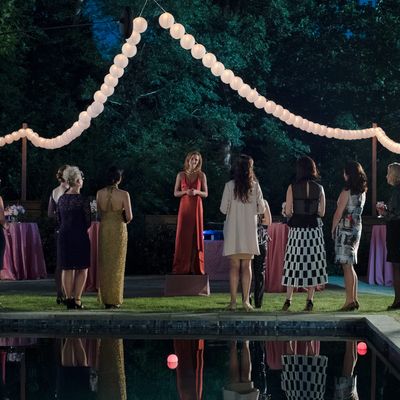
It was a wretchedly hot afternoon in Atlanta; at 94 degrees Fahrenheit, it would go on record as the hottest day of the month. But no one needed to explain this to the 50-odd women outfitted in brocade pantsuits and satin dresses, trying to stay cool in the backyard of a house on the set of the series finale of Halt and Catch Fire. Clustered in the shade outside, the women dabbed themselves with cocktail napkins the PAs had passed out, while others huddled around a fan inside. Grips laid down about 20 feet of track along the west side of the yard so they could do sweeping shots with a 15-foot Super Techno Crane, suspended over the pool like an arm hanging on a sofa. At the center of the swirl of extras, cameras, and crew stood Kerry Bishé in a light-pink terrycloth bathrobe and slides, going over the speech her character, Donna Emerson (previously, Clark), was about to deliver.
The heartfelt two-page monologue about being a woman in tech was one of the hardest parts of the finale for Christopher Rogers and Christopher Cantwell, the co-creators and showrunners, to write. “It makes textual what should be subtextual,” said Rogers. “I don’t like to overtly moralize in the show, but it felt like we’d earned it.” The speech was text as meta-text, too. As Donna talks about the challenges of working as a woman in a male-dominated industry, the resonance wasn’t lost on Bishé or any of the other actresses assembled that night. It was a triumphant punctuation for Donna, who by all appearances, began as a secondary character in the pilot of Halt and Catch Fire — a nagging foil to the troubled geniuses of the show like Joe MacMillan (Lee Pace), Cameron Howe (Mackenzie Davis), and her ex-husband Gordon Clark (Scoot McNairy).
It was 6:55 p.m. by the time shooting began, and only a few clouds dotted an otherwise still-bright summer sky. The script, though, called for dusk, which inevitably raised a production question: How do you make four hours of shooting time look like five minutes of twilight? At the very least, it meant that episode director Karyn Kusama and the DP (director of photography) Evans Brown were chasing the sunset.
It takes a village, especially on a television set. What follows is a behind-the-scenes look at how Donna’s big scene came together.
The Writing
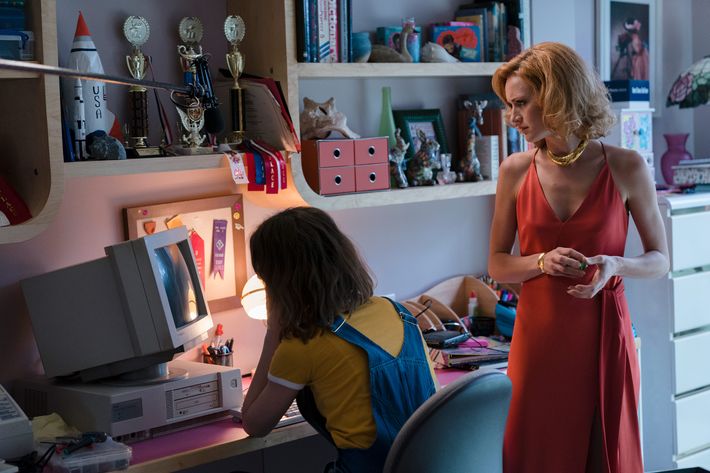
Each script of Halt and Catch Fire is color-coded according to which draft it is. The first draft the actors read is white; depending on how many drafts they write, the sequence that follows is blue, pink, and yellow. Christopher Rogers and Christopher Cantwell, simply known as the Chrises on set, got into the yellow pages for the finale episode, which is fairly typical for their writing process. Donna’s speech in particular proved to be one of the biggest writing challenges. “I did a million versions of the speech because one of the worst sins you can commit is to come off as preachy, and we’ve really tried to live our principles with that versus advertising them,” said Rogers. “That’s what I’m scared most about.”
In her speech, Donna touches on the history of computer science, and how women, who once populated the field, started to get pushed out as it grew in importance. “It’s the overt ‘messaging’ that we try to make subtextual in a lot of what we do,” said Rogers. “It is textual tonight, but I think we’ve earned it because of Donna’s journey from this housewife who put her own ambitions away in the first season to the head of this VC firm, where she ends up at the end of season four. The knowledge of that journey and the bumps on the road afford her the ability to speak about it in a personal way.”
Much of that has to do with her relationship with Cameron. “I am a woman who voted her female partner out of her own company — the company she founded,” Donna says in the speech, as Cameron listens on. “The one constant is this: It’s you. It’s us. The project gets us to the people, because it’s people that got me where I am. People like Diane Gould. People like my husband and my first partner, Gordon Clark. People like my last, and best, partner, Cameron Howe.” It’s around this point when the two lock eyes and a tear trickles down Cameron’s face.
“Essentially, this season is a love story between them,” Rogers said of the Cameron-Donna relationship. “They make this emotional reconnection in the aftermath of Gordon’s death, but the professional one is scary and touches all the old wounds. They’ve been splintered apart, the ‘will they, won’t they’ of getting back and working together again threads through the whole season.”
The Location
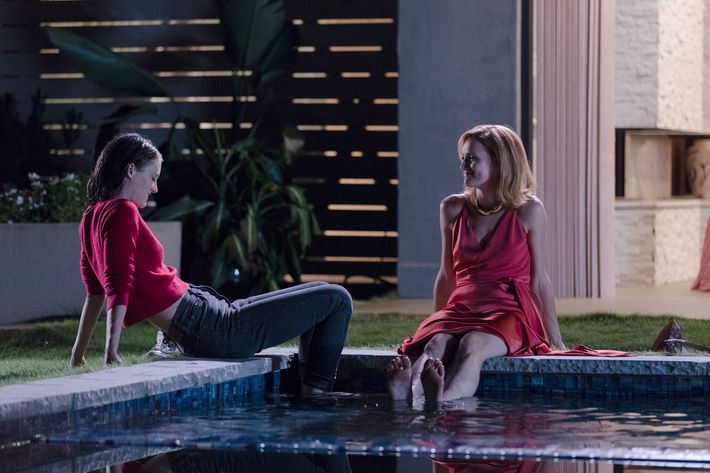
Episode director Karyn Kusama, DP Evans Brown, and production designer Ola Maslik scouted the house where Donna would live. It was a replica of a mid-century modern home in a quiet neighborhood in the northeastern part of Atlanta. They liked its clean, unfussy lines, which would be able to accommodate ornamental touches to tailor it to Donna’s taste and the time period. “I needed a house which had minimalist architecture so we could do whatever we wanted,” said Maslik. “We decided we were just going to use it as the location because it’s easier to have a beautiful pool than imitate something onstage.”
It was important to convey a certain status for Donna, who emerges in this final season as a rising executive at the VC firm where Diane Gould (Annabeth Gish) brings her on. The color palette was very ’90s: dusty rose and emerald green, which appears on the backsplash in the kitchen, the tablecloths outside, the blinds, furniture, and other accents. For the party, they wanted to convey a serene sense of luxury, with bouquets of off-white peonies, strings of paper lanterns, and floating lights in the pool. “[Donna] used to live in a house, and now she’s like, ‘Oh my god, I’m just going to buy this amazingly designed mid-century modern house and decorate it with a designer,’” said Maslik.
One feature they had to contend with was the slope at the back of the yard. Maslik and set director Lance Totten built a raised wooden platform that they then would cover with sod so the lawn would be level. It allowed them to place small bars behind Donna as she speaks to the group, but it also meant that all nonessential personnel needed to stay off the platform lest it break.
The Direction
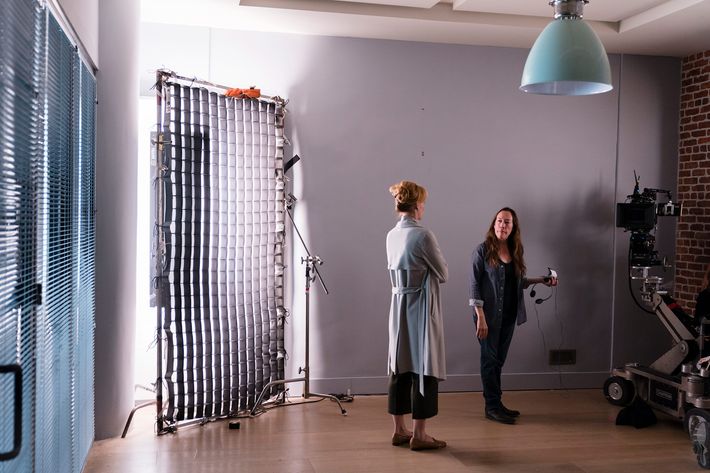
Executive producer Melissa Bernstein finally got her wish to have Karyn Kusama direct an episode for the final season. Bernstein pushed to bring Kusama on in the first season, and the Girlfight director has done one episode per season since. Bernstein wanted to continue the tradition for the fourth and final season, but Kusama was navigating some scheduling conflicts with her film with Nicole Kidman, Destroyer. “I’ve been begging Karyn to direct all season,” said Bernstein. “Eventually, I think she just folded to wanting to be a part of bringing this series to a close. It just felt right.”
For this scene in particular, Kusama was analyzing space and how to shoot the two central characters, Donna and Cameron. Donna would stand near the edge of the pool, facing the group of women looking back at her house, with Cameron moving from inside the house along the edge of the pool toward Bishé. The dolly came into play for Davis’s coverage: The camera would sweep over the pool as she walked alongside it. “I imagine what the scene calls for and the best spatial relationships to set up,” said Kusama. “It’s funny because TV demands you think pretty quickly of actual, basic spatial understanding, so even though it gets a bad rap that you have to work this quickly, for me it’s a great exercise because I have to be thinking about cinema language in the most effective, efficient way.”
In terms of what the space is supposed to convey thematically, “it’s really about the emotional piece that Cameron and Donna have arrived at,” Kusama explained. “The scene is really moving to me, because it’s about this imaginative space where women acknowledged the struggles, the hardships, the accomplishments that other women have made.”
The Lighting

“I used to stress about the weather when I did day exteriors the night before,” said Brown, the director of photography. “Now I just don’t look anymore. The lighting gods will be with me or they won’t be.” That day, they weren’t. Since the scene took place during dusk, an overcast day would have helped; instead, it was hot and bright with barely any cloud coverage, otherwise known as “the worst nightmare.” “The scene takes about four hours to shoot, and you have an hour of dusk,” he said. “So you have three hours there that you have to make look like dusk when the sun’s out.”
How do you make it look like dusk when there’s a 94-degree sun beating down on you? The key grip, Bill Merrill, set up a truss tower that allowed them to tether a giant, helium-filled mattress balloon called a grip cloud that floated over the entire backyard. To the west side, they set up charcoal solids to block out the sunlight, making the backyard a dim cocoon. “Then it’s just a matter of balancing the interior lighting with the higher ambient light levels from outside,” explained Brown. In other words, with the backyard under shadow, they could amp up the light coming from inside the house so the entire scene would look darker on camera.
The real trouble, though, came after sunset, because it’s easier to take away light and create shadow than it is to add light to darkness. However, they always have the option of smoothing things out in postproduction. And because it’s much easier to adjust colors for close-up shots than it is for wide shots in post, they held off on shooting Bishé’s close-up until the end. When it was time to film it, the gaffer, Rick Crank, used a 120-foot condor, a giant panel of light attached to a crane, to light the treeline behind her as a way to add light to the scene. “We lit the shit out of it,” said Brown. “No matter how hard you try, you’ll never make it look like the sun, but you just do the best you can, and in the final color they help you out a little bit.”
The Look
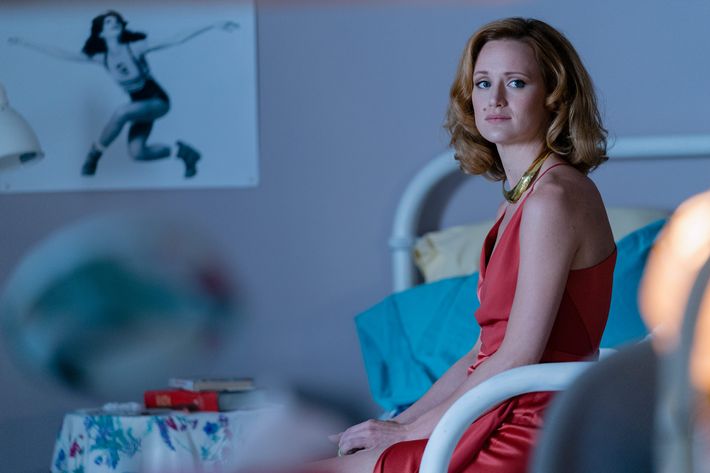
The costume design, makeup, and hair teams worked to complement the dusky-rose color palette that Maslik had created for the production design. The costume designer, Jennifer Bryan, outfitted Bishé in a chic silk-wrap dress in a deep coral color. The makeup played off of the same tones. “Being that this was a party, we pumped her up a bit more than if this was just an everyday 1994 look,” said Donna Premick, the head of makeup. “Everything is very earthy tones, like your rust colors and burnt oranges.” Meanwhile, the hair design by Joani Yarbrough was conceptualized with Bishé. They lightened her hair to a “light copper” from the deeper red it had been since they moved the show to California. “I was like, You’re so Ann-Margret. You know, big and sexy and powerful,” said Yarbrough.
The Acting
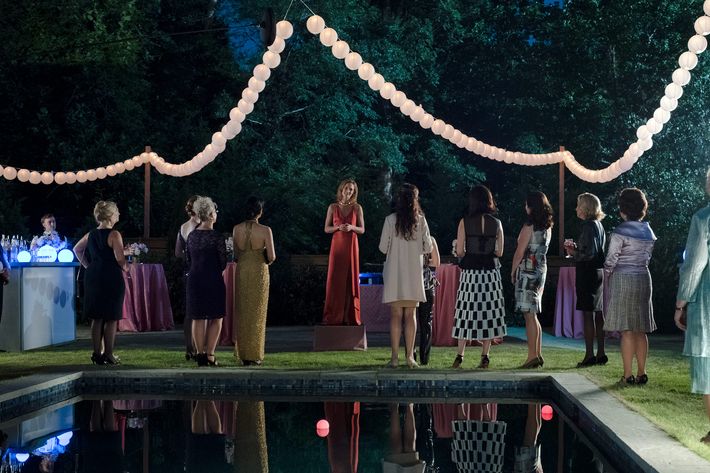
Kerry Bishé didn’t want to over-prepare for her speech; she let herself feel the words as she said them. Having played the character of Donna Clark for four seasons meant she had a trove of memories to draw upon. “There wasn’t going to have to be a whole lot of technical pretending or acting, really,” she said. “There was so much about that speech that’s completely, totally truthful and honest. I can look at the crew that I love and say how proud I am to be on this journey with you and mean it 100 percent. I get to talk to Mackenzie and look in her face and tell her what a great partner she’s been, and it’s all just so true. It’s a very honest confession and celebration.”
That, and the fact that the words she was saying could be easily applied to her own experiences in Hollywood. “One of the lines in it that always gets me is when she’s like, ‘I hope that when my daughters are my age, they don’t have to have gatherings like this to remind themselves they’re actually here.’ And what’s hard about that is … that’s me,” said Bishé. “My generation is those daughters, and we’re still having these gatherings and conversations. You think about all the ‘Women in Hollywood’ dinners and cocktail parties.”
Still, reciting a two-page speech multiple times can be an exhaustive feat. By the time Bishé began shooting her coverage, it was 9:09 p.m., the sun had set, and the cicadas were chirping in the background. Bishé stood on the dais in the dark of night surrounded by equipment — two cameras, lights, and reflective solids with the grip cloud hovering overhead — while giving the speech. Only this time, there weren’t scores of women surrounding her: just the cameramen, Kusama, Rogers, and the overeager homeowner looking at the monitors in the video village directly in her sight line. “That speech was easy to do 100 times when everyone was there,” said Bishé. “I wish I’d asked them to keep some of the background around, because I was trying to look at a flowerpot here, and then there’s a grip scratching his butt over there, and I’m like, Oy. This was so meaningful earlier.”
Still, Bishé powered through, and when they got the shots they needed, Kusama exclaimed, “Kerry, you’re a fucking cyborg.”
The Reacting
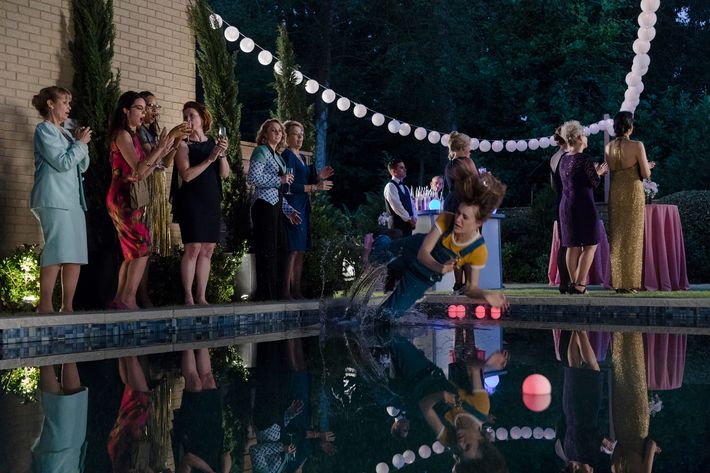
“I felt it was a really good fall,” Mackenzie Davis said soon after she fell into the pool in the closing moment of the scene. The production did one test run with her double doing the fall before Davis took her turn, which she nailed in one take. “I’m just a very clumsy person. I can’t, like, orchestrate a beautiful fall, but I can trip into something,” said Davis. “That’s my lifestyle.”
As for the speech itself, Davis thought a lot about her own career and the fact that women have to keep having this conversation in every sphere. “There are certain lines that are pretty fucking heartbreaking when you think that, even though this is all an imaginary world, it’s still 1994!” she said. “It’s sad thinking that this was very relevant then, relevant now, will still be relevant in ten years.”
For Gish, who plays Donna’s mentor, Diane, it was an opportunity to think about the current sea change happening in Hollywood. “I think the old egomaniacal, patriarchal, power-hungry executive way doesn’t work anymore,” she said. “And I’ll tell you, especially as you get older, I don’t want to waste my time working with assholes.”
“As I was listening to Kerry speak,” Gish continued, “I felt like everything was synonymous with that journey. You fight hard, you make sacrifices, and it hasn’t been easy. I’ve been doing this for 35 years, you know? But I’m here. There’s something to be said for enduring.”


